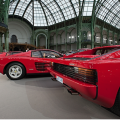The Dashboard Lights Are Flashing
USING HISTORY TO DETERMINE THE “WHEN” AND “IN WHAT FORM” OF THE INEVITABLE COLLECTION CAR MARKET CORRECTION
Over the past several months, the collector car world has been abuzz over the escalation of values and the potential for a market downturn. Most everyone is fluffing off the idea, citing new people pouring into the arena, the collector car world now being a global community, values finally getting to where they should be, and other equally valid points.
As long time readers know, I never view “the collector car market” as just that, or something to be looked at in isolation. Rather, by examining it as a commodity market in which collector cars are bought and sold, this allows us to compare what is happening in it with other asset classes, with no bias. And for the first time in years, I’m becoming increasingly uneasy by what I see.
The first dashboard warning light flashed late last year/early this year when a friend returned from the UK. He’d made the rounds to see a number of buds at the established collector car dealerships, and heard of a new trend. All the dealers talked about people coming into their facilities, wishing to purchase Ferrari Daytonas and Dinos, but these new faces didn’t have a clue as to what the cars were. All they knew was they should have both.
This chillingly mirrors a quote in a book I just completed on Ferrari’s supercars that will be out in October, where long time dealer Brandon Lawrence of Sports Cars Italiano in northern California talks of the late 1980s boom. “We had consortiums of doctors and such that took their retirement plans and put the money into modern and older Ferraris,” he remembered. “That’s when I started to get nervous, for they didn’t know a Dino from a Daytona, only that they had to have both.”
Old timers will no doubt recall what happened 12-24 months after that trend took hold…
A second dash light went off several weeks later while visiting a well-known auction principal. “Things are getting really crazy,” he said. “Even when we get world record prices, our consignors are upset that we didn’t get them enough.” When I reflect on this, I can’t help but flash on what uber-investor Warren Buffet famously said: “Be fearful when others are greedy, and greedy when others are fearful.”
Right now, everyone is greedy, and that mentality is spreading beyond the ultra hot Ferrari market. Shane Mostoe is a car-guy of the first order, and owns Brighton Motorsports in Scottsdale with his wife Karen. Their inventory sweet spot is $30,000-300,000+, and he recently noted how difficult it has become to buy anything. “Everybody is in the collector car market now,” he said, “in a way that reminds me of the real estate boom several years ago (an arena where Shane had incredible success). People aren’t buying for the love of the car but for investment reasons. Guys are selling cars out of their house, or buying one or two to put in their garage, and calling them ‘a collection.’”
He then told the tale of a Porsche owner who recently had his semi-desirable car for sale. When Shane offered below the asking price, the owner declined. Not much time passed when the owner had several bids at the ask price, only to decide he wanted 20% more.
Shall we queue the Buffet quote again?
More alarming was a phone conversation with an established east coast dealer. Within 24 hours of a Gooding email listing of some of the early consignments for their Monterey auction, the dealer got a call inquiring about a Ferrari 275 GTS he had for sale. After a pleasant conversation, and answering questions, the caller bought the car, telling the dealer that he had seen Gooding’s estimate on the auction’s 275 GTS, and “didn’t want the market to run by him.”
For as long as I’ve written this blog, I’ve firmly believed at least 50% of the dramatic rise in car values can be attributed to the printing of money and the manipulation of interest rates by central banks, and people’s slow, unacknowledged loss of faith in the paper currencies in their wallets (you can read more here). But when auction estimates and not actual sales become the catalyst for someone to spend that type of money ($1.7+ million), something is seriously out of whack, indicative that we are probably closer to the end of exploding car values than the beginning.
Several years ago, one of my favorite financial analysts (an extremely astute and humble contrarian named Steve Sjuggerud) dubbed this expansionary monetary policy and asset price inflation as the “Bernanke Asset Bubble.” Named after former Fed Chair Ben Bernanke, the whole process was best summed up by Lewis Lerhmanm. “With…the central banks issuing money directly to the banks through the process of quantitative easing and direct bailouts,” the investment banker and co-founder of the Gilder-Lerhmann Institute on American History pointed out a year ago, “the financial class is in a position of getting money first. (They) borrow money at 1% and buy commodities, speculate in stocks and front run the Fed on buying bonds.”
How prescient that observation was, for recently a good friend who oversees a very tasty collection told me about being in a meeting with the collection’s owners, as their bankers offered to lend them tens of millions of dollars at—you guessed it—1%. While these guys are very content with their collection, and not looking to add, how many others are sitting on the sidelines, when a 1% carry charge carrot is dangled in front of them?
There’s no way of knowing how often such pitch sessions are occurring but we can see the influence, in all facets of the market—witness a Volvo P1800 wagon that brought nearly $100,000 in June. Outside that auction tent, the car has perhaps 20% of that value on a good day, and an intrinsic value much less than that in the automotive grand scheme of things.
Then there was the Lamborghini LP400 Countach that Bonhams sold for $1.2 million at the same auction. I owned a factory hot rod LP400 for several years in the late 1990s, and always thought the car had capital appreciation written all over it. But $1.2 was a staggering number, even for one who expected LP400s to rise in value. Seven years ago, LP400s struggled to bring $200,000, and a six-fold increase in price in that time frame is not normal market behavior.
The LP400 is not alone. Ferraris, Porsches, Mercedes, and other marques have had numerous models spike tremendously in value in the last five years—really, when one looks at it, starting around the time the Bernanke Asset Bubble began.
So what happens when markets get this overheated? I remember living in the San Francisco Bay Area in the late 1980s when real estate went up 30+% a year for three years in a row. Then it crashed. Last decade, when there was easy credit, numerous residential areas around America went up at astounding rates for several years then crashed.
In 1998, a barrel of oil cost around $10. Ten years later it was $140, and then the price crashed. In the second half of the 1990s the technology-laden NASDAQ Composite went up 500% in five years, including 80% in the last several months, then crashed.
And closer to home, in the second half of the 1980s the car market seriously spiked in price, with 250 GTOs going up at $100,000 a month clip (it would be several times that amount today). When the 1990s began GTO prices fell 80%, and the rest of the market cratered and remained depressed for a number of years. And for those who did not experience that precipitous drop, look at the muscle car market’s insane price inflation from 2000 to 2007, and what happened after that. Only now are muscle cars values starting to recover.
Which brings us to today, with the Monterey week barreling towards us. In the past few weeks more and more mega-dollar cars have signed up to be sold at the mid-August automotive and auction orgy. Just recently Bonhams rocked the collector car world, stating they would auction off a 250 GTO at no reserve (the last sold for a reported $52 million in a private transaction earlier this year). Several days later the auction house announced another nine Ferraris would go off the same night also at no reserve, all but one likely bringing seven (and possibly eight) figure hammer prices.
Bonhams isn’t alone. Last week RM said it would sell one of the three 275 GTB Competiziones ($20-30+?), and this morning (July 23) Gooding announced one of the two 365 Ps ($15-20+?), plus they reportedly have a 250 SWB ($10+) that could be made public at any day. This unprecedented amount of heavy merchandise coming to market at once makes me wonder if there will be enough money around to absorb it.
What is eerie is, as this is happening, the most expensive of stock market activities—the corporate merger—is in the midst of its own mega-boom. According to Thompson Reuters, $5 billion mergers are at the highest number since 2007, the total value of those deals up more than 200% in the last year alone.
A number of astute people I follow feel that type of merger activity is the sign of a top, so could that amount of expensive machinery (with a number of cars having multi-decade ownership), all being sold at once in Monterey, be a similar harbinger for the car market? The honest answer is nobody knows, for there is another corollary that says, “markets can go up far higher, for far longer than anyone ever imagined.”
Meaning we could have a ways to go, for as they say in the art business, “it’s not a bubble until it bursts.”
We’ll now hit the brakes on our market correction/not a bubble discussion, and return to where we started. Right now everyone is acting greedy; well, everyone except one dealer friend. He’s been around the block a few times, and has his entire collector car inventory on sale at Monterey. His desire? Not to own a single one when the auction lunacy is over on August 18.
He’s either early to the exit or the smartest guy I know, for history says 100% odds the market will correct. Nobody knows when, but that doesn’t make it any less dangerous to walk into a playing field where everyone is acting like prices will never go down. While I’m not expecting anything close to the 80% haircut of early 1990s when the correction appears, should you find yourself at Monterey next month with a bidder paddle in hand, the best advice is this: Buy because you truly desire the car, for reasons other than price appreciation.
That way, you can never go wrong. You will enjoy the car for what it actually is, rather than what others perceive it to be worth.




